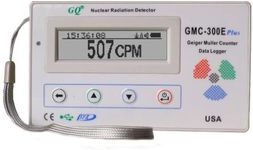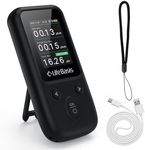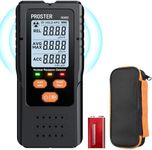Buying Guide for the Best Geiger Counters
Choosing the right Geiger counter can be a bit overwhelming, but understanding the key specifications can help you make an informed decision. A Geiger counter is a device used to detect and measure ionizing radiation, which is important for ensuring safety in environments where radiation is present. Whether you need it for professional use, educational purposes, or personal safety, knowing what to look for will help you find the best fit for your needs.Radiation Types DetectedThis specification indicates the types of radiation the Geiger counter can detect, such as alpha, beta, gamma, and X-rays. It's important because different applications may require detection of specific types of radiation. For example, if you are working in a medical environment, gamma and X-rays might be more relevant, whereas alpha and beta particles might be more important in a laboratory setting. Choose a Geiger counter that detects the types of radiation you are most likely to encounter.
SensitivitySensitivity refers to the Geiger counter's ability to detect low levels of radiation. This is crucial for ensuring accurate readings, especially in environments where radiation levels are expected to be low. Sensitivity is often measured in counts per minute (CPM) per unit of radiation. Higher sensitivity is better for detecting low levels of radiation, while lower sensitivity might be sufficient for environments with higher radiation levels. Consider your specific needs and the typical radiation levels you expect to encounter when choosing the sensitivity.
Measurement RangeThe measurement range indicates the minimum and maximum levels of radiation the Geiger counter can measure. This is important because it determines the device's capability to handle different radiation intensities. A wider range is beneficial for versatility, allowing the device to be used in various settings, from low-level background radiation to high-level radiation environments. Choose a Geiger counter with a measurement range that covers the expected radiation levels in your specific application.
Display and ReadoutThe display and readout feature refers to how the Geiger counter presents the radiation measurements. This can include digital displays, analog meters, or even audio signals. A clear and easy-to-read display is important for quickly understanding the radiation levels. Some models also offer additional information such as dose rate and cumulative dose. Consider how you will be using the device and choose a display type that is easy for you to interpret and suits your needs.
Data Logging and ConnectivityData logging and connectivity features allow the Geiger counter to record measurements over time and connect to other devices for data transfer. This is important for tracking radiation exposure over extended periods and for detailed analysis. Some models offer USB connectivity, Bluetooth, or even cloud storage options. If you need to keep detailed records or analyze data, look for a Geiger counter with robust data logging and connectivity features.
Battery LifeBattery life indicates how long the Geiger counter can operate on a single charge or set of batteries. This is crucial for ensuring the device is reliable and available when needed, especially in fieldwork or emergency situations. Longer battery life is generally better, but also consider the type of batteries used and whether they are easily replaceable or rechargeable. Choose a Geiger counter with a battery life that matches your usage patterns and ensures continuous operation when required.
Durability and Build QualityDurability and build quality refer to how well the Geiger counter can withstand physical wear and tear, as well as environmental conditions such as dust, moisture, and temperature variations. This is important for ensuring the device remains functional in various settings, especially in harsh or demanding environments. Look for models with robust construction, protective casings, and any relevant certifications for durability. Choose a Geiger counter that can handle the conditions you expect to encounter.

















